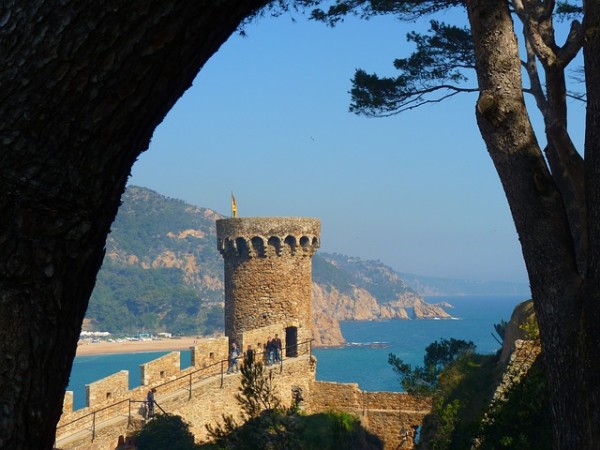The very southern Costa Brava is in the comarca of La Selva, which literally means “the forest”.

The castle at Tossa de Mar protected the town from pirates
La Selva is where the forest-covered Cadiretes massif meets the sea between Lloret de Mar and Sant Feliu de Guíxols (Baix Empordà) resulting in a rugged coast with many coves. It’s worthwhile driving along here just for the scenery. Inland is an extensive plain where much of the land is used for agriculture, while in the west is more forest covering the Guilleries mountain range and Montseny massif.
The capital of La Selva is Santa Coloma de Farners, a town that dates from at least the ninth century. The town is notable for the church of Santa Coloma, which dates from the 14th century and as a spa town, for which it became popular in the early 20th century. You can stay at the Balneari Termes-Orion today. Nearby are also a 12th century castle and the Monastery of Sant Pere Cercada.
But in some areas of the coast picturesque coves contrast radically with nearby over development. Blanes was once a village that survived on fishing and agriculture but today its principal industry is tourism. Inhabited in pre-Roman times, today it is sometimes known as “the gateway to the Costa Brava”, but it has lost some of its charm. The the seafront is dominated by apartment buildings.
Much worse is Lloret de Mar. The nucleus of the town was lost following the unchecked development that started in the 1960s. That and the way Lloret was promoted helped tarnish the reputation of the entire Costa Brava. But if you know where to look, there are still gems around Lloret.
Fenals beach is much better than Lloret’s main beach, which is lined with block after block of apartment buildings. Lying on the sand at Fenals you can almost forget what is around the corner as the botanical gardens overlook the beach.
Even better is the Santa Cristina beach. While it has quite a large hotel high on the cliffs above, the beach isn’t completely straightforward to get to and tends not to get overcrowded even at the height of summer. Above it is an 18th century hermitage with a steep path down to the beach.
Nature
Part of the Montseny Natural Park lies in La Selva. Here is the Montseny massif which at its highest point reaches more than 1700 metres. The area has been protected since 1987 and, uniquely, is home to an endangered species of newt. The area also has a number of megaliths. These indicate it was inhabited in very primitive times, perhaps several millennia BC.
The is also the Estany de Sils, which until the mid 19th century was the largest lake in Catalonia. It was drained in 1851 and the resulting reclaimed land used for growing crops. However in the late 20th century a project was set up by the Generalitat (Catalan Government) backed by the European Union to buy back some of the reclaimed land to convert to marshes and ponds. The final part of the plan is to re-establish a lake and forest. The area here is extremely damp and it’s sometimes prone to huge fog banks. The AP7 toll road goes by Sils and can be affected by the fog.
Three out of the Costa Brava’s four botanical gardens are located in La Selva. Marimurtra Botanical Garden and Pinya de Rosa Tropical Botanical Garden are both in Blanes, while Santa Clotilde Gardens is in Lloret de Mar.
History
I already mentioned Santa Coloma de Farners, but it isn’t the only spa town in the southern Costa Brava. Caldes de Malavella is famous for its sparkling water and you can visit the remains of the town’s Roman baths.
Water brands include Vichy Catalan, Malavella and San Narciso and there are also two traditional spas with warm water provided direct from the springs below. These are Balneari Vichy Catalan, located right next to the bottling plant, and Balneari Prats. If you’re not staying at either of these spas the former has an hour long “thermal circuit”, with two warm water pools, sauna and various other water treatments. The latter has a warm water pool in its gardens available to non-guests during the lunch period.
While Blanes and Lloret de Mar have been largely spoilt, Tossa de Mar has a fantastic 14th century castle towering over the town’s main beach. Within the walls is a lighthouse. Tossa was originally settled at the end of the Stone Age and is believed to have been populated ever since. Later it became an Iberian settlement followed soon after by the Romans. Although on the coast, Tossa’s main industries starting in the middle ages were wine and cork rather than fishing. These days of tourism is the town’s main breadwinner.
People
Tossa de Mar may be something of a faded glory these days but in 1951 Ava Gardner spent time in the town to shoot Pandora and the flying Dutchman with James Mason. There is a life-size statue of the actress watching over the town from within the castle walls.

